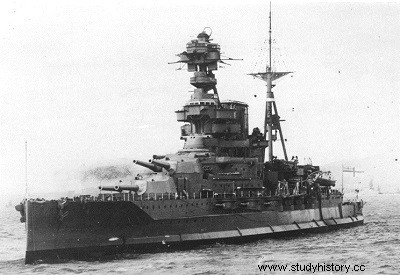
The Germans were, however, able to exert sufficient pressure to induce their allies to attack the British convoys. They encouraged them by announcing that, on March 16, in the eastern Mediterranean, Luftwaffe torpedo planes had disabled two of Cunningham's three battleships, which was false. But the Luftwaffe having promised to help the Italians, it was now difficult for them to go against the wishes of their Axis partner.
The Italian operation, mounted by the Admiral Yachino, Commander-in-Chief of the Fleet, was to launch from mainland ports eastward two waves of cruisers that would sweep the waters north and south of Crete. The northern force was to advance as close as possible to the eastern tip of the island, while the southern force would go as far as the island of Gavdhos, located on the southwestern outskirts of Crete. In all, six cruisers armed with 203 mm guns, two armed with 152 mm guns, as well as nine destroyers were to be employed with the support of the largest ship then available in the Italian Navy, the Vittorio Veneto, a building of 35,000 tons, brand new, armed with 9 381 mm guns and making 30 knots.
The Italian units therefore left, as discreetly as possible, their bases in La Spezia, Taranto, Brindisi and Messina, and the “raking” began on the morning of March 27. All day the Italians sailed east, and all day they waited in vain for the air cover promised by their allies.
But if the Luftwaffe was conspicuous by its absence, the R.A.F. was, for its part, represented by an isolated Sunderland seaplane which, at 12.30 p.m., sighted, about 75 miles east of Sicily, three of the Italian cruisers sailing towards Crete. Cunningham, three of whose battleships (Warspite, Valiant and Barham) were anchored in Alexandria, decided to put them to sea, but to wait until nightfall, so that their departure would not be known until as late as possible. The decision made, he implemented a personal plan intended to deceive the enemy:suitcase and golf clubs in hand, he went ashore in order to give the impression that he was going to spend the afternoon and the night far away. of his flagship. But aboard the Vittorio Veneto were codebreakers whose skill served the Italian fleet, and Iachino soon learned that the "Sunderland" had spotted some of his forces. There could therefore no longer be any question of surprise. However, if the entire Italian fleet retreated, the situation would again become tense between Italians and Germans. , while the cruisers Zara, Pola, Fiume, and escort destroyers joined the rest of the Italian ships off Gavdhos. The following day, at 7:22 a.m., they sighted an advancing British force coming from Greece, commanded by Vice-Admiral Pridham-Wippell (cruisers Orion, Ajax, Gloucester, Australian cruiser Perth, and four destroyers). Of the two opposing forces, the Italians were the better armed and faster, so the British retreated to draw the enemy on Admiral Cunningham's battleships.
The Italians pursued them , opening fire from 13 miles away, and continuing to fire for some forty minutes, until Admiral Iachino feared he had come too close to the British bases. He then ordered them to fall back to the west to join the Vittorio Veneto. Pridham-Wippell also changed course; from pursued, the British became pursuers. At 10:58 the Orion sighted the Vittorio Veneto. The British veered once more side to side and sped towards Cunningham's side, hiding behind smoke screens and under the repeated salvoes of the 381 mm guns of the Vittorio Veneto. The English ships found themselves
in great danger of being caught in the crossfire:the Italian cruisers which had pursued them, and which were now to the south, and the Vittorio Veneto which was heading north. at full speed.
